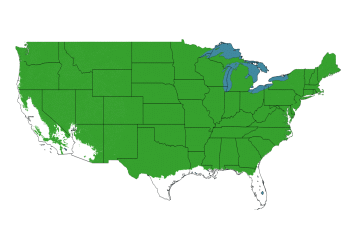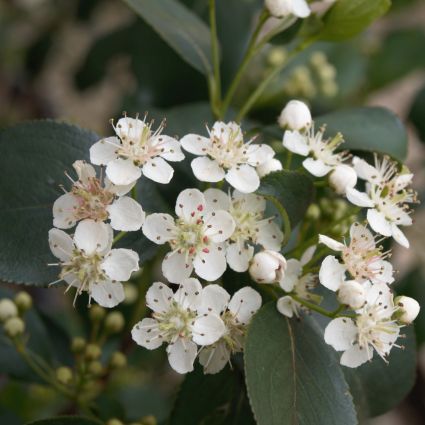✖
Black Chokeberry
Aronia melanocarpa var.elata
As low as
$99.99
In stock
SKU
PFY-638
Antioxidant-Rich Fruit, Fall Color Black Chokeberry
- Darling Flowers in Spring
- Lustrous Green Summer Foliage
- Gorgeous Red, Purple and Orange Foliage in Fall
- Very Healthy, Edible Fruit in Fall
- Can the Fruit, Or Extract the Juice for Jelly
- 30 - 40 Pounds of Fruit Per Shrub
- Upright, Mounded Growth Habit
- Attracts Butterflies
- Supports Song and Game Birds
- Low Maintenance
- Sun, Partial Shade or Shade
- Include in Rain Gardens
- Tolerates Road Salt
People are using native shrubs like Black Chokeberry (Aronia melanocarpa var.elata) as part of a big design trend in gardening. And it is no hardship to include a compact variety that looks great all growing season.
Black Chokeberry is found in low-lying wooded areas, and has a very adaptable nature. Grow it in wet or acidic soils, in full sun, partial sun or shade. It even tolerates road salt, so can be incorporated into street plantings.
Black Chokeberry delivers a lot of ornamental charm. In spring, you'll enjoy the beautiful, 5-petaled flowers. They are white with a subtle pink highlight.
The flowers eventually develop into clusters of berries. Watch them as they go from green to red, to purple and finish black.
Each healthy berry is similar to a small blueberry and can be added to smoothies, jams, jellies and sauces. The fruit production from each plant can be up as much as 30 or 40 pounds on each plant.
With one of the highest levels of antioxidants, Aronia berries are well on its way to becoming the new must-have super food. And you can easily grow it in your yard.
Aronia berries have been extensively studied. The fruit is a powerful antioxidant over 400% higher than blueberries.
This potent medicinal fruit has been shown to slow the growth of cancer. It also slows the age-related reduction in learning and memory.
Just add honey or sweetener to your recipes. It's not nicknamed Chokeberry for nothing!
Brighten up the shady areas of your landscape with this dainty, easy-care shrub. The small summer leaves are lustrous and catch the available light.
In fall, you'll be so pleased to see the deep, rich color of the foliage. Each shrub is alight with red, orange and purple tones for a brilliant autumn display.
This is a wonderful native plant that brings many bird species to your yard. The berries are especially welcomed by birds during the coldest time of winter, when food is scarce.
Order this special variety from the expert growers at LetsPlantify.com today! You'll leave a legacy bigger than yourself with this wise choice.
How to Use Black Chokeberry in the Landscape
Use deciduous Black Chokeberry for seasonal color and edible fruit. Plant one for definition in your garden or several as a low hedge.
It will grow into an upright, rounded shrub and can be used for screening. Plant them 2 feet apart on center, measuring from the center of one to the center of the next.
Chokeberry will provide you with exceptional spring and fall interest. Give it a prominent spot in your design.
Add them to the edge of woodlands, or place them in back of Butterfly Gardens. Repeat them along the length of your mixed borders.
Be sure to try your hand at making homemade Aronia juice, jelly or dehydrated berries. Enjoy a glass or a handful of prepped berries every day for a big dose of antioxidants, anthocyanins and polyphenols.
Top your salad with sweetened dried berries, or add them to trail mix, pancakes or oatmeal.
They are also fabulous as a meat sauce for pork, turkey and chicken. If you like dry, red wine, try eating them raw.
Use this shrub in wildlife gardens and edible landscapes, and mixed shrub borders. Include a hedgerow around your home orchard to give a beautiful sense of definition.
Hedges can also be used as snow fencing along a long driveway. No need to trim them, just give about 4 feet from the concrete to reach their full, natural spread.
Black Chokeberry Aronia also make a very refined specimen plant anchoring a corner of your house. You'll appreciate the elegant foliage both summer and fall.
Anywhere you use it, you'll see a lift in the quality of light, as the leaves are quite reflective. The fall color display is outstanding!
#ProPlantTips for Care
Growth and fruit production is best in full sun, but Black Chokeberry will tolerate partial shade. Likewise, well-drained soil is best, but they are adaptable.
Aronia is best pruned by removing the oldest stems out to the ground in early spring. Leave the thinner, younger stems in place to maintain the natural form and produce lots of fruit and flowers.
Provide moderate moisture on a regular basis. Place a thick layer of mulch over the top of the root system.
We are big fans of the Chokeberry family of shrubs here at LetsPlantify.com. They are wonderful accent shrubs that can be used in almost any yard. Order today!
| Botanical Name | Aronia melanocarpa var.elata |
|---|---|
| Mature Height | 3 - 6 feet |
| Mature Spread | 3 - 6 feet |
| Soil Type | Widely Adaptable |
| Moisture | Moderate |
| Sun Exposure | Full Sun, Full Shade, Partial Shade |
| Growth Rate | Slow |
| Bloom Period | Early Spring, Late Spring |
| Flower Color | White |
| Foliage Color | Green |
| Fall Color | Orange, Red, Burgundy / Purple |
| Pollinator Required | No |
| Pollinator Friendly | Yes |
| Growing Zone Range | 3-8 |

Write Your Own Review

